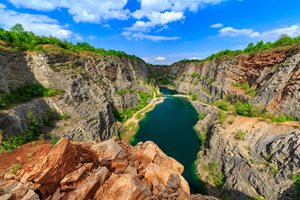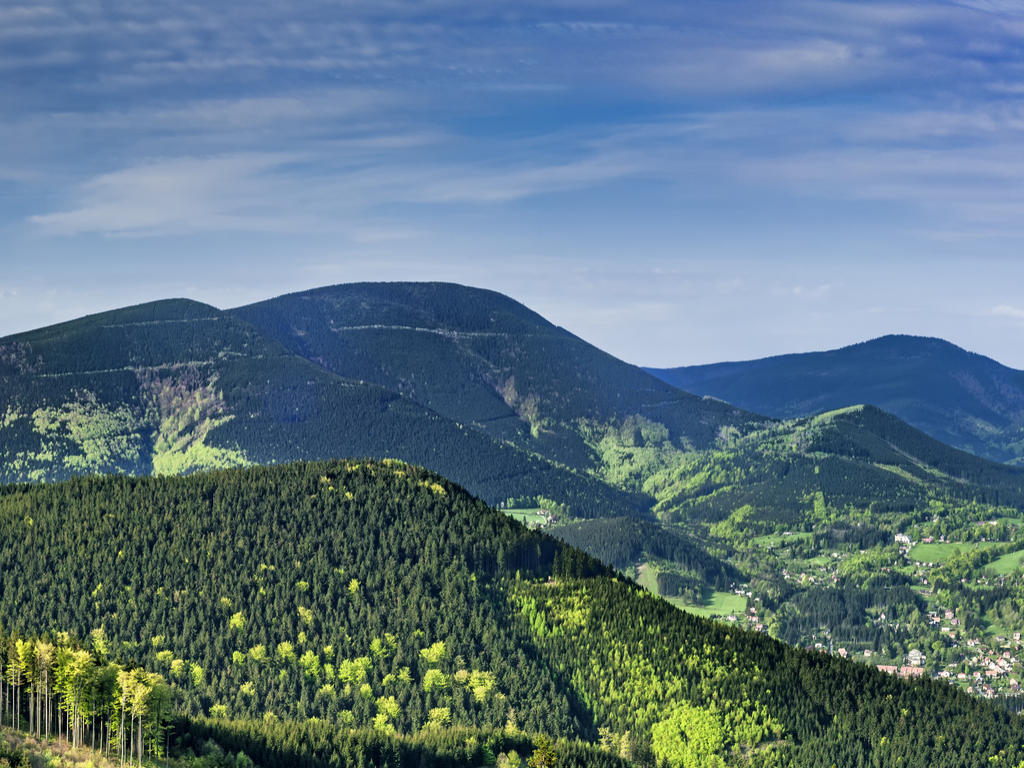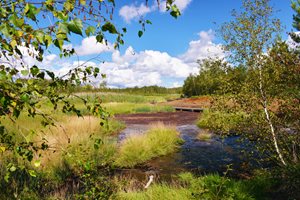The Czech Republic is well known for its historical sites. But if you make it to the heart of Europe on your travels, wouldn’t be a shame to spend all the time in the city? We have some recommendations for beautiful and unique paths through the woods, caves under the ground, and trails through the treetops.
Velká Amerika: A Former Quarry Near Prague
 The abandoned quarry called Velká Amerika (Great America) can be found near Karlštejn Castle just outside of Prague. It is known as the Czech Grand Canyon. Limestone used to be extracted there, and the now-flooded quarry is 800 metres long, 200 metres wide, and up to 100 metres deep. On the bottom, there are two connected lakes with crystal-clear water. The water beckons you to take a dip, but entering it is not allowed. You can look at the quarry safely from a lookout point right next to the car park, or from the footpaths that go around Velká Amerika. And when there, take the opportunity to hike along the marked trails to see the majestic royal castle of Karlštejn from all sides. You will be surprised to meet only a few tourists there, compared to the town of Karlštejn below the castle. The surrounding hillsides are covered with dense deciduous woods, and in spring the ground is covered with a carpet of spring flowers of all colours and shapes.
The abandoned quarry called Velká Amerika (Great America) can be found near Karlštejn Castle just outside of Prague. It is known as the Czech Grand Canyon. Limestone used to be extracted there, and the now-flooded quarry is 800 metres long, 200 metres wide, and up to 100 metres deep. On the bottom, there are two connected lakes with crystal-clear water. The water beckons you to take a dip, but entering it is not allowed. You can look at the quarry safely from a lookout point right next to the car park, or from the footpaths that go around Velká Amerika. And when there, take the opportunity to hike along the marked trails to see the majestic royal castle of Karlštejn from all sides. You will be surprised to meet only a few tourists there, compared to the town of Karlštejn below the castle. The surrounding hillsides are covered with dense deciduous woods, and in spring the ground is covered with a carpet of spring flowers of all colours and shapes. Macocha: A Karst Abyss Near Brno
 South Moravia has an unmistakable charm. There are not only wine cellars and vast vineyards around Brno, but also a unique karst region called the Moravian Karst. At the centre of the protected landscape area is the Macocha Abyss and the sinking creek of Punkva. Macocha was created when the ceiling of a large underground karst dome collapsed, and its bottom today lies at a depth of about 160 metres. The sun shines all the way down to the bottom, and it is the deepest abyss of its kind in Central Europe. You can look inside Macocha with a guide, or take an unforgettable ride in a boat on the Punkva creek. There are hiking trails around the abyss, letting you explore what an unspoiled deciduous forest in Central Europe looks like in spring.
South Moravia has an unmistakable charm. There are not only wine cellars and vast vineyards around Brno, but also a unique karst region called the Moravian Karst. At the centre of the protected landscape area is the Macocha Abyss and the sinking creek of Punkva. Macocha was created when the ceiling of a large underground karst dome collapsed, and its bottom today lies at a depth of about 160 metres. The sun shines all the way down to the bottom, and it is the deepest abyss of its kind in Central Europe. You can look inside Macocha with a guide, or take an unforgettable ride in a boat on the Punkva creek. There are hiking trails around the abyss, letting you explore what an unspoiled deciduous forest in Central Europe looks like in spring. Valaška Trail at Pustevny
.jpg.aspx?width=300&height=225) The Beskids, where the new treetop trail known as Valaška is located, lies near Ostrava, the industrial centre of the region. About thirty minutes from the city by car and you’ll find yourself in a land of peace, well-being, and mountainous nature. The treetop trail starts at the top of the chairlift station at Pustevny. The structure includes a 22-metre-high lookout tower, from which you can see the Jeseníky Mountains and Slovakia. The trail offers two unique technical designs: a suspension trail and a glass lookout point, both for the purpose of evoking the feeling of standing in the air. And where should you go when you have taken in enough of the views? Hike to the statue of the pagan god Radegast, or to the Chapel of Ss Cyril and Methodius. The options are countless.
The Beskids, where the new treetop trail known as Valaška is located, lies near Ostrava, the industrial centre of the region. About thirty minutes from the city by car and you’ll find yourself in a land of peace, well-being, and mountainous nature. The treetop trail starts at the top of the chairlift station at Pustevny. The structure includes a 22-metre-high lookout tower, from which you can see the Jeseníky Mountains and Slovakia. The trail offers two unique technical designs: a suspension trail and a glass lookout point, both for the purpose of evoking the feeling of standing in the air. And where should you go when you have taken in enough of the views? Hike to the statue of the pagan god Radegast, or to the Chapel of Ss Cyril and Methodius. The options are countless.Toulovcovy maštale Near Litomyšl
 This nature preserve with sandstone rocks lies near the east Bohemian city of Litomyšl and its chateau that is a jewel of Renaissance architecture. The preserve is called Toulovcovy maštale. It is a group of narrow gorges that create a hidden rock city, interwoven with a network of passageways, caves, and holes with unusual names such as the Kitchen, the Cellar, the Mouse Hole, and the Bell. The rocks are made of Cretaceous sandstones of marine origin. You may spend hours wandering around not meet another person on the many footpaths and trails. And how can you get there from Litomyšl? Ask in the city information centre. You can hop on the regular bus service to the village of Budislav and then just find the red trail marker.
This nature preserve with sandstone rocks lies near the east Bohemian city of Litomyšl and its chateau that is a jewel of Renaissance architecture. The preserve is called Toulovcovy maštale. It is a group of narrow gorges that create a hidden rock city, interwoven with a network of passageways, caves, and holes with unusual names such as the Kitchen, the Cellar, the Mouse Hole, and the Bell. The rocks are made of Cretaceous sandstones of marine origin. You may spend hours wandering around not meet another person on the many footpaths and trails. And how can you get there from Litomyšl? Ask in the city information centre. You can hop on the regular bus service to the village of Budislav and then just find the red trail marker. Soos Nature Reserve in West Bohemia
 West Bohemian spas are known for their hot springs, which are residual manifestations of long-extinct volcanos. The thermal springs in Karlovy Vary and Františkovy Lázně are famous. And it is near Františkovy Lázně where you can find the national Soos Nature Reserve. It is a large peat bog and moor with a lot of mineral springs and pure carbon dioxide coming out of mud volcanos. Follow the educational trail along the bottom of a dry lakebed, which used to be full of salty mineral water a long time ago. And what do you have to look forward to? A fantastic moon landscape, furrowed by erosion and covered by a yellow and white layers of crystallised mineral salts. There are many protected animals and a number of swampy and halophilic plants. Unfortunately it is not possible to access the whole reserve,: you can only hike along the trail that is over one kilometre long. But make no mistake: there is no other place like this in the Czech Republic.
West Bohemian spas are known for their hot springs, which are residual manifestations of long-extinct volcanos. The thermal springs in Karlovy Vary and Františkovy Lázně are famous. And it is near Františkovy Lázně where you can find the national Soos Nature Reserve. It is a large peat bog and moor with a lot of mineral springs and pure carbon dioxide coming out of mud volcanos. Follow the educational trail along the bottom of a dry lakebed, which used to be full of salty mineral water a long time ago. And what do you have to look forward to? A fantastic moon landscape, furrowed by erosion and covered by a yellow and white layers of crystallised mineral salts. There are many protected animals and a number of swampy and halophilic plants. Unfortunately it is not possible to access the whole reserve,: you can only hike along the trail that is over one kilometre long. But make no mistake: there is no other place like this in the Czech Republic. Spring in the Jizera Mountains Near Liberec
 The protected landscape area of the Jizera Mountains lies near Liberec and is easily accessible, and so it is very popular with Czech people. But their accessibility is not the only reason for their popularity: these mountains also offer rough beauty and numerous marked hiking and cycling paths. The mountains are especially beautiful in spring when the snow melts at higher altitudes and the mountain meadows wake up with a shower of blooming flowers. You can hike up the second-highest peak of the range, Jizera, with its distinct rocky silhouette that can be seen from afar. From Jizera, you can continue through ancient spruce forests towards the Bedřichov dams, or to Josefův důl.
The protected landscape area of the Jizera Mountains lies near Liberec and is easily accessible, and so it is very popular with Czech people. But their accessibility is not the only reason for their popularity: these mountains also offer rough beauty and numerous marked hiking and cycling paths. The mountains are especially beautiful in spring when the snow melts at higher altitudes and the mountain meadows wake up with a shower of blooming flowers. You can hike up the second-highest peak of the range, Jizera, with its distinct rocky silhouette that can be seen from afar. From Jizera, you can continue through ancient spruce forests towards the Bedřichov dams, or to Josefův důl. Unique Zbrašov Aragonite Caves
 Central Moravia, particularly with its university city of Olomouc, is slowly appearing in the pages of popular guides. It’s chic, historical, and it has not yet been affected by mass tourism. About 30 kilometres from Olomouc, the spa of Teplice nad Bečvou hides a rare treasure: the Zbrašov Aragonite Caves. It is a unique cave system unique and significant in Europe, formed by the dual effects of rain and warm mineral waters rising from huge depths in the limestone layers. The unique formations are formed by aragonite, raft stalagmites, and spherical sinter crusts, resembling doughnuts. The lowest levels of the caves are permanently filled with carbon dioxide gas. But don’t worry, you won’t go that far with the guide. In spring, the bats that winter there wake up after their hibernation, and so you’ll have a unique opportunity to meet these tiny flying mammals.
Central Moravia, particularly with its university city of Olomouc, is slowly appearing in the pages of popular guides. It’s chic, historical, and it has not yet been affected by mass tourism. About 30 kilometres from Olomouc, the spa of Teplice nad Bečvou hides a rare treasure: the Zbrašov Aragonite Caves. It is a unique cave system unique and significant in Europe, formed by the dual effects of rain and warm mineral waters rising from huge depths in the limestone layers. The unique formations are formed by aragonite, raft stalagmites, and spherical sinter crusts, resembling doughnuts. The lowest levels of the caves are permanently filled with carbon dioxide gas. But don’t worry, you won’t go that far with the guide. In spring, the bats that winter there wake up after their hibernation, and so you’ll have a unique opportunity to meet these tiny flying mammals.








-(1).jpg?width=1920&height=1204&ext=.jpg)

